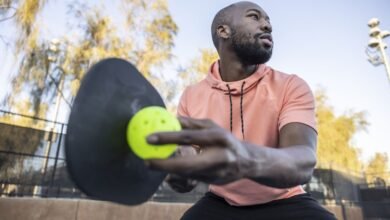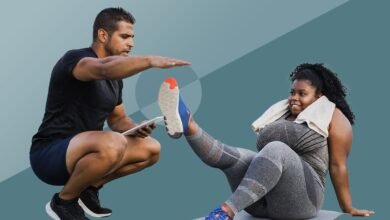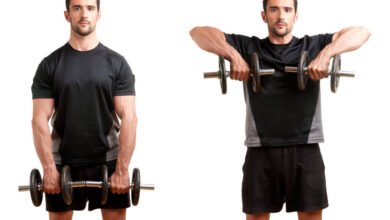The Power of Recovery: Techniques for Muscle Repair and Growth

In the pursuit of strength, muscle growth, and overall fitness, people often focus intensely on their training regimen, pushing their limits and seeking the best workout routines. However, one critical aspect that is often overlooked is the power of recovery. Recovery is an essential part of any successful training program, and understanding its significance can enhance your performance, prevent injury, and lead you to your ultimate fitness goals, whether you’re looking for mass-made simple or simply seeking an alternative to overhead press exercises for shoulder development.
In this comprehensive guide, we will explore the different techniques of recovery, their importance in your fitness journey, and how they can optimize your training efforts.
The Power of Recovery for Muscle Growth
Before we dive into the techniques of recovery, it’s essential to understand why recovery is critical for muscle growth and overall fitness:
-
Muscle Repair
When you engage in resistance training, such as lifting weights, you create small tears in your muscle fibers. Recovery is the process through which your body repairs these tears, ultimately leading to increased muscle size and strength. This process occurs primarily during rest and requires adequate nutrition to support muscle repair.
-
Hormonal Health
Intense exercise can impact your hormonal balance, leading to temporary increases in cortisol (a stress hormone) and decreases in testosterone. Proper recovery techniques can help regulate these hormones, which are vital for muscle growth and overall health.
-
Injury Prevention
Training without sufficient recovery increases the likelihood of injuries. Overuse injuries occur when the same muscle groups are continuously worked without adequate rest. Listening to your body and allowing for recovery helps prevent these injuries and ensures longevity in your training.
-
Performance Enhancement
Optimal recovery will lead to improved performance during subsequent workouts. When your body is well-rested, you can push harder, lift heavier, and maintain better focus and motivation in your training sessions.
Techniques for Effective Muscle Recovery
Now that we understand the importance of recovery, let’s explore various techniques that can improve muscle repair and growth:
-
Active Recovery
Active Recovery involves engaging in low-intensity physical activity after intense workouts to enhance blood flow and aid in the recovery process. Examples include:
- Light jogging or walking: This can help reduce muscle soreness and improve circulation.
- Yoga or stretching: Gentle stretches can promote flexibility and release tension in the muscles.
Incorporating active recovery days into your regimen allows your body to recover without being completely sedentary.
-
Nutritional Strategies
Nutrition plays a vital role in recovery, with the following strategies being particularly effective:
- Protein Intake: Consuming protein after your workouts provides the amino acids necessary for muscle repair. Aim for around 20-30 grams of high-quality protein within 30 minutes post-workout. Products or supplements that help you gain mass made simple can include protein shakes, cottage cheese, or eggs.
- Carbohydrates: Carbs help replenish glycogen stores depleted during exercise. Pairing protein with carbohydrates post-workout can optimize recovery.
- Hydration: Staying hydrated is crucial for recovery. Water aids in nutrient transport and helps flush out toxins. Aim to drink enough fluids throughout the day, especially before and after your workouts.
-
Quality Sleep
Sleep is one of the most critical yet often neglected components of recovery. During sleep, your body undergoes crucial repair processes, including:
- Hormonal Regulation: Sleep is when growth hormone levels peak, promoting muscle repair and growth.
- Cognitive Function: Quality sleep enhances focus, mood, and motivation for your upcoming workouts.
Aim for 7-9 hours of quality sleep each night. To improve sleep quality:
- Establish a consistent sleep schedule.
- Create a calming bedtime routine.
- Limit blue light exposure from screens before bed.
-
Stretching and Mobility Work
Incorporating stretching and mobility exercises into your routine can significantly enhance your recovery.
- Dynamic Stretching: Perform dynamic stretches before workouts to prepare your body for exercise and improve circulation.
- Static Stretching: Post-workout, static stretching helps improve flexibility and promotes relaxation. Stretch the muscles worked during your training to alleviate tension.
Mobility work can also help improve joint range of motion, which is particularly important for lifts like the overhead press or any alternative to overhead press exercises that target the shoulders while ensuring minimal risk of injury.
-
Foam Rolling and Self-Myofascial Release
Foam rolling is a popular recovery technique that helps to release muscle tension, improve tissue quality, and enhance blood flow. Here’s how it works:
- Technique: Use a foam roller on sore or tight muscle groups, rolling slowly to massage the muscle, and spend extra time on particularly tight areas.
- Frequency: Incorporate foam rolling sessions into your post-workout routine or on active recovery days.
-
Cold and Heat Therapy
Using temperature can be effective for muscle recovery and injury prevention. Here’s how to utilize both cold and heat therapy in your recovery regimen:

Cold Therapy for the power of recovery
Cryotherapy involves using cold temperatures to reduce inflammation, swelling, and pain, specifically after intense workouts.
- Ice Packs: Apply ice packs to sore muscles for 15-20 minutes immediately following a workout to help reduce inflammation and numb pain.
- Ice Baths: If you’re feeling particularly sore, an ice bath can be an effective way to reduce muscle soreness after a challenging strength training session. Submerging your body in ice-cold water for about 10-15 minutes can significantly reduce inflammation.
- Cryotherapy Chambers: Many gyms and wellness centers now offer localized or whole-body cryotherapy as an advanced recovery option. This technique involves exposing the body to extremely cold air for minutes to promote recovery.
Heat Therapy for the power of recovery
Using heat can promote blood flow, relax muscles, and ease stiffness.
- Heating Pads: Apply heating pads or warm towels to tight muscles, particularly in the back, glutes, or anywhere else you may feel tension.
- Warm Baths: A warm bath can help relax your body and improve circulation.
- Saunas: Spending time in a sauna can help relax muscles and improve recovery through increased blood flow.
-
Massage Therapy
Massage therapy is another recovery technique that can be beneficial for muscle repair.
- Deep Tissue Massage: This type of massage targets deeper layers of muscle and fascia, helping release chronic tension and knots which can accumulate from heavy lifting or intense training.
- Sports Massage: A tailored approach for athletes, sports massage focuses on specific muscle groups that are overworked and aids in alleviating muscle soreness and improving flexibility.
Consider scheduling regular massage sessions, especially before and after intense phases of training, to enhance your overall recovery process.
-
Supplements for Recovery
Certain supplements can enhance recovery and prepare your muscles for the next workout. Here’s a look at some popular options:
- BCAAs (Branched-Chain Amino Acids): These are essential amino acids that support muscle recovery and can help reduce soreness after intense workouts. Consider taking BCAA supplements during or immediately after workouts to enhance recovery.
- L-Glutamine: This amino acid supports muscle recovery, reduces soreness, and enhances gut health. It can be beneficial, especially during intense training phases.
- Creatine: While primarily known for boosting strength and performance, creatine can also aid recovery through improved cellular energy, which can speed up muscle repair.
- Protein Powder: Essential for recovery, whey protein or plant-based protein powders consumed post-training can optimize muscle repair and growth, fitting seamlessly into a mass made simple approach.
- Omega-3 Fatty Acids: Found in fish oil, Omega-3s have anti-inflammatory properties and can help support recovery from training-induced muscle soreness.
-
Recovery and the Mental Aspect
Recovery isn’t just physical; it’s also essential to acknowledge mental recovery. Mental fatigue can significantly impact your performance and recovery. Here are strategies to enhance mental recovery:
- Mindfulness and Relaxation: Practices like meditation, deep breathing, or yoga can help reduce stress levels, enhance recovery, and improve focus for your future workouts.
- Positive Visualization: Visualizing success in your workouts can increase motivation and confidence. Visualize how you want your speech or workout to accomplish forming strong, powerful muscles or achieving personal bests.
-
Implementing Recovery Techniques into Your Training Regimen
To make recovery an integral part of your training routine, consider the following steps to integrate recovery techniques into your weekly plan:
- Schedule Active Recovery Days: Dedicate certain days to lighter activities, stretching, foam rolling, or yoga. This could be once or twice a week, depending on your training intensity.
- Include Post-Workout Nutrition: Have a post-workout routine that includes adequate amounts of protein and carbohydrates. Prepare a protein shake or meal with proper macronutrient balance to aid recovery.
- Prioritize Sleep Hygiene: Establish a bedtime routine that promotes relaxation and improves sleep quality. Sleep is an undervalued component of recovery and was mentioned earlier as crucial in the muscle repair process.
- Listen to Your Body: Pay attention to how your body responds post-workout. If you’re consistently sore or fatigued, it may indicate a need to tweak your training or incorporate more recovery techniques.

Importance of muscle recovery
Understanding the importance of recovery techniques is vital in achieving your fitness goals, whether you are focused on building muscle, aiming for mass made simple, or seeking alternatives to mainstream lifts like the alternative to overhead press. Implementing these strategies not only enhances muscle repair and growth but also prepares your body for future workouts, preventing injury and promoting long-term success.
By focusing on various recovery techniques—from active recovery and nutritional strategies to sleep hygiene and incorporating massage therapy—you empower your body to adapt to training demands placed upon it. Here are some additional considerations and more nuanced recovery techniques to further enhance your recovery routine:
-
Hydration and its Importance
Adequate hydration is often overlooked but plays a pivotal role in recovery. Here’s why staying hydrated matters:
- Nutrient Transport: Water is essential for the transport of nutrients throughout the body. Proper hydration helps deliver essential amino acids and other nutrients to muscle cells, promoting more effective recovery.
- Temperature Regulation: Hydration helps maintain body temperature during exercise. Proper fluid balance prevents overheating and enhances performance.
- Muscle Function: Dehydrated muscles can lead to cramps and decreased performance. Keeping hydrated ensures that your muscles function smoothly and reduces recovery time.

Hydration Tips:
- Start your day with water and aim to drink consistently throughout the day.
- Consider electrolyte-rich drinks during extended workouts, especially in hot weather, to replenish lost minerals.
-
Periodization in Training
Implementing a strategy of periodization in your training program can maximize both performance and recovery. This involves structuring your training into specific cycles or phases that vary in intensity and volume. By alternating the focus of your workouts, you allow certain muscle groups to recover while challenging others.
For example:
- Microcycles: Short training segments (usually 1-4 weeks) focusing on specific outcomes (like strength, hypertrophy, or endurance).
- Mesocycles: Mid-length training segments (usually 1-3 months) that focus on broader phases, such as building mass or emphasizing recovery.
This systematic approach helps prevent burnout and overtraining, making recovery a built-in part of your overall training philosophy.
-
Contrast Baths and Hydrotherapy
Hydrotherapy can be an effective method to alleviate soreness and promote recovery:
- Contrast Baths: Alternating between cold and hot water immersion can stimulate circulation. For example, you might spend 3 minutes in cold water, followed by 1 minute in warm water, repeating the cycle multiple times. This method is especially beneficial after large training sessions.
- Hydrotherapy Pools: If accessible, spending time in a hydrotherapy or warm water pool can help soothe sore muscles and improve circulation.
-
Awareness of Overtraining
Monitoring your body for signs of overtraining is critical in your recovery strategy. Overtraining can lead to decreased performance, fatigue, and increased risk of injury. Keep tabs on these indicators:
- Persistent Muscle Soreness: If you consistently feel sore, it may be a signal that your body is not recovering properly.
- Fatigue: Unusual feelings of fatigue that do not go away with rest.
- Mood Changes: Increased irritability, mood swings, or lack of motivation can be a sign of overtraining.
To combat overtraining, consider implementing more rest days, reducing overall training volume, or integrating lighter periods into your workout schedule.
-
Sports Psychology and Mindset
Incorporating a positive mindset into your recovery can significantly influence your progress and performance. Sports psychology techniques can aid in mental recovery:
- Setting Realistic Recovery Goals: Just as you set performance goals for your workouts, set specific recovery goals to keep yourself accountable.
- Positive Affirmations: Use positive affirmations to bolster your motivation and recovery mindset. Phrases like “I am capable of recovery” can reinforce your commitment to your recovery process.
- Mindful Recovery: Practice mindfulness or meditative strategies that can aid in relaxation and help you unwind from stressors outside of your training environment.
-
Record and Reflect on Your Progress
Keeping a workout journal is beneficial for recovery monitoring. Record not only your workouts but also how you feel post-training. Note down:
- Muscle soreness levels
- Energy levels
- Sleep quality
- Nutritional intake
By reviewing your notes after several weeks, you can identify patterns and make necessary adjustments to both your training and recovery strategies.
-
Incorporating Recovery Technology
The emergence of recovery technology has opened new avenues for enhancing recovery processes. Consider investing in:
- Massage Guns: These devices can provide targeted relief to sore muscles and enhance blood flow.
- Compression Therapy Devices: How they work: These devices apply pressure to your limbs to improve circulation and reduce muscle soreness.
- Sleep Enhancement Devices: Wearable technology can help track your sleep quality, providing insights into how well your body is recovering overnight.
-
Integrating Rest Days Wisely
Rest days are vital for muscle recovery, and understanding how to structure them can maximize their effectiveness:
- Complete Rest vs. Active Recovery: Decide if you need a complete day off or if you would benefit from light physical activity such as walking, cycling, or swimming. Choose based on how you feel to avoid burnout.
Timing of Rest Days: Schedule rest days after intense training sessions or when you notice signs of fatigue and soreness to allow your body the time it needs to recover fully. Here are some strategies for integrating effective rest days into your training regimen:
-
Utilize the “Rest-Train” Cycle
Implementing a Rest-Train Cycle: A well-planned training schedule that alternates between intense training days and rest days can optimize performance and recovery.
- Example Structure:
- Day 1: Heavy strength training (legs and back)
- Day 2: Medium-intensity lightweight training or cardio
- Day 3: Rest day or active recovery (yoga, walking)
- Day 4: Heavy strength training (upper body)
- Day 5: Rest day
- Day 6: Intense cardio or a sport
- Day 7: Total rest or active recovery
This type of structure not only gives your muscles time to recover but also ensures variety in your training, reducing the risk of mental burnout.
-
Experiment and Personalize Your Recovery Plan
Everyone’s body responds differently to various recovery techniques. It’s essential to experiment with different strategies and make adjustments based on what works best for you. Keep an open mind and maintain flexibility in your recovery protocol based on:
- Individual Response: Some may find ice baths most effective, while others might prefer active recovery.
- Lifestyle and Preferences: Choose recovery methods that fit your lifestyle and that you genuinely enjoy, ensuring commitment to the recovery process.
As you figure out your personalized recovery formula, you will be better positioned to maintain consistency and progress.
-
Stay Informed and Educated
Knowledge is power when it comes to effective recovery. Stay informed about new and upcoming recovery techniques, research studies, and expert recommendations.
- Learn and Adapt: Follow credible fitness resources, read textbooks, and attend courses or workshops focusing on recovery.
- Network with Professionals: Consider consulting with personal trainers, physical therapists, or nutritionists for tailored advice regarding recovery strategies based on your training goals.
-
A Holistic Approach to Recovery
Lastly, fostering a holistic approach to recovery is key to overall well-being. Recovery is not solely about physical muscle repair; it involves nurturing your mental, emotional, and social health as well.
- Social Interaction: Engage with friends, family, or fellow fitness enthusiasts. Social connections can provide motivation and serve as a form of mental recovery.
- Mental Stimulation: Embrace hobbies or interests outside of fitness to promote a well-rounded approach to health and wellness. Activities like reading, art, or meditation can enhance mental fatigue and promote emotional well-being.

Conclusion
In summary, recovery is not merely an afterthought; it is an essential component of achieving your fitness goals, whether you’re striving for mass made simple or aiming for a more balanced and functional training routine that incorporates alternatives to overhead press exercises. Understanding and implementing effective recovery techniques enables your body to repair itself and encourages muscle growth.
Ultimately, the key takeaway is to approach recovery holistically—integrate various techniques that cater to your physical needs, emotional state, and training regimen. Consider your lifestyle, personal preferences, and individual needs when developing your recovery strategy.
Engaging with your recovery positively can create a lasting impact on your training performance and enjoy a healthier lifestyle. Remember, a well-recovered body is not just ready for the next workout; it thrives under pressure and is capable of delivering peak performance.
By prioritizing recovery, you enable yourself to achieve the best results every single day—ensuring that you’re not just working hard but also working smart on your journey toward fitness excellence.
-Terry Asher




